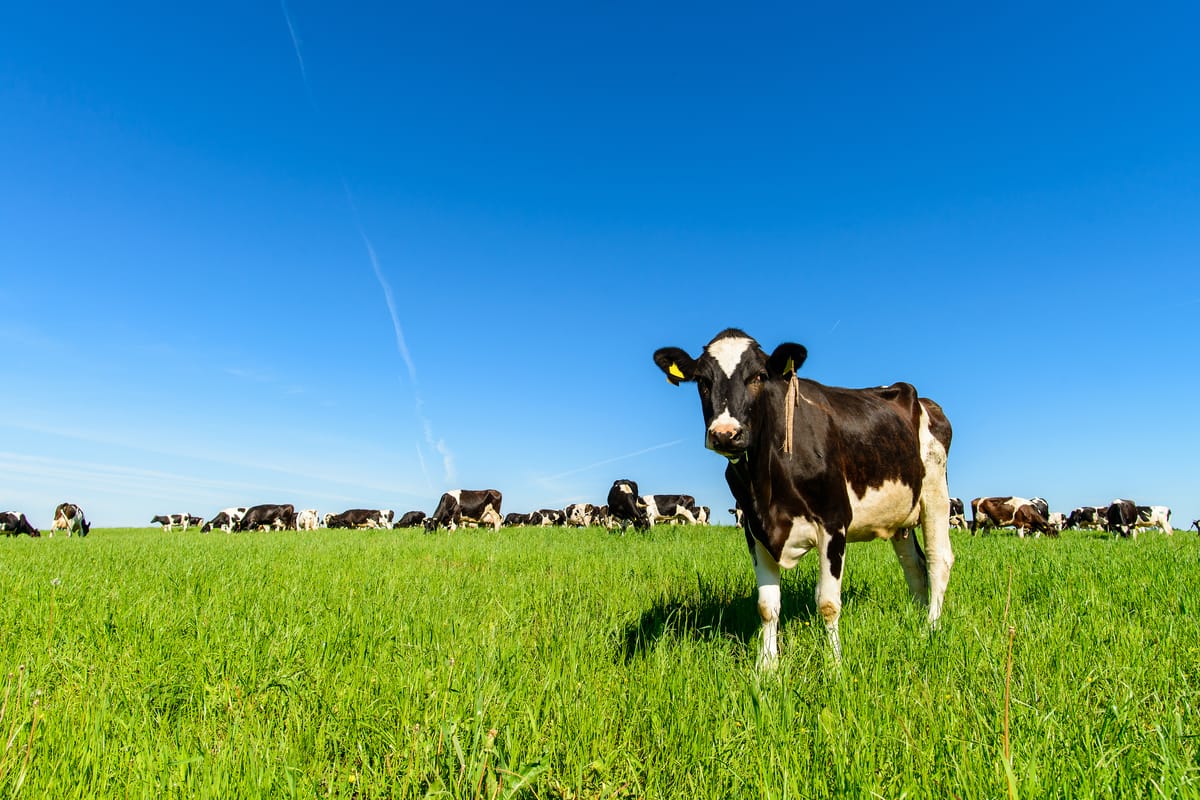This week, we dive into efforts by large companies and startups to reduce dairy emissions, reforms in Massachusetts to cut food waste, and Google's new investment in carbon credits from direct air capture.
Follow Tectonic on Instagram and LinkedIn for regular updates about the innovators and innovations moving climate ambition into action.
Cutting emissions from cows: The dairy industry accounts for just under 5% of global carbon emissions — more than the aviation or shipping industries. For large food companies like Mars, which has roughly 200,000 dairy cows across its supply chain, dairy is a major contributor to their carbon footprint. Each cow produces 95 kilograms of methane a year, a greenhouse gas that has 80 times the warming power of carbon dioxide. Working with a farming cooperative in Germany and the Netherlands, Mars is investing $47 million over three years to reduce these emissions, including altering the cows' feedstock with red seaweed supplements that reduce their methane emissions by 40-80%, managing manure to cut another 10% of emissions, embracing regenerative agriculture, and securing high-quality carbon credits for further offsets.
“Dairy is the second biggest contributor to our carbon footprint, so cutting methane inevitably is an important part of our journey.” — Amanda Davies, chief research and development, procurement and sustainability officer at Mars
Dairy-free cheese startup raises $61 million: German fermentation startup Formo raised $61 million in its Series B to scale production of its dairy-free cheese from fungal microorganism Koji protein. The startup is working to take a slice of the $240 billion global cheese market and reduce the dairy industry's climate impact. Formo's cream cheese product generates 65% fewer emissions, uses 83% less land, and requires 96% less water than dairy-based cream cheese.
Massachusetts leads in effective bans on food waste: Researchers analyzed the first five U.S. states to implement bans on commercial food waste: California, Connecticut, Rhode Island, Vermont, and Massachusetts. The study found that Massachusetts was the only state to reduce waste ending up in landfills, achieving a 13.2% reduction in waste and 25.7% decrease in methane emissions per ton of waste. The success was attributed to the state implementing a simple law with few exceptions, an established network of composting infrastructure, easy access to facilities to process food waste, and strong enforcement.
Patagonia commits $1 million to advance regenerative farming in California: Patagonia's nonprofit Holdfast Collective granted $1 million to the Rodale Institute to help Californian farmers transition from practices using pesticides to regenerative organic agriculture. With an additional $1.5 million in support from the California Department of Food and Agriculture, the program will provide technical assistance, business planning, certification support, and equipment stipends and help farmers earn a premium for their certified organic or regenerative organic produce.
Climate finance comes into focus ahead of COP29: At COP15 in 2009 in Copenhagen, wealthy nations pledged to increase climate finance for developing countries to $100 billion annually by 2020, a goal that was reached behind schedule in 2022. At COP26 in Glasgow, nations decided to set a new goal by this year. Now, figuring out the scope of the New Collective Quantified Goal (NCQG) will be a significant focus when leaders meet for COP29 in Azerbaijan this November. Negotiators are behind on resolving several central items, including the overall size of the commitment, structuring support as grants instead of loans, and ensuring commitments are additional and not siphoned off from other foreign aid. A new UN report estimated the annual figure needed by developing nations to be $500 billion. Climate finance and new emissions reduction targets were both key priorities discussed by top White House climate advisor John Podesta and his Chinese counterparts last week.
Google announces deal on direct air capture: Google announced a deal to purchase 100,000 carbon credits from Holocene at a price of $100 per ton for delivery by the early part of the next decade. The credits, which result from taking carbon dioxide out of the air, are priced far lower than the $600 per ton charged by competitors. If Holocene can deliver at this price point, the deal marks a milestone in financial feasibility and competitiveness for direct air capture technology. Holocene launched in 2022, and funders include the U.S. Department of Energy, Elon Musk's Xprize Carbon Removal, and Bill Gates’s Breakthrough Energy.
Batteries save California's electrical grid: The chief executive of California's biggest utility company, PG&E, pointed to the state's ability to store and deploy energy as needed as a key factor for the grid's resilience during the past summer's extreme heat waves. This marked a significant improvement from four years ago when residents saw rotating outages during higher temperatures. The batteries charge during the day when solar power is abundant, and the state now has about 10 gigawatts of utility-scale battery capacity — enough power storage for about 7.5 million homes and businesses.
Brookfield invests up to $1.1 billion in green fuel: Brookfield Asset Manager will invest up to $1.1 billion in e-fuel startup Infium. The deal includes a $200 million investment in Infium's West Texas project and up to $850 million in other projects around the world. Infium produces fuels that can be used in planes, ships, trucks, and manufacturing in a process that combines water, carbon dioxide waste, and renewable energy. The startup will be a producer of sustainable aviation fuel, which the EPA estimates will need to grow 122-fold by 2030 to fulfill industry commitments, including from United Airlines and Delta, as well as EU mandates on percentages of aircraft fuel being sustainable.
Chinese startup targets cutting costs of nuclear fusion in half: Energy Singularity based in Shanghai is looking to raise $500 million to develop cheaper, next-generation nuclear fusion technology. Inspired by work at MIT, the company has been developing a machine using high-temperature superconducting (HTS) material central to its fusion power plants at a much smaller scale, greatly reducing overall costs. The company's leaders say that footprint, coupled with lower costs of locally sourced materials and labor, means the company can build at half the costs of producing the same machinery in the U.S.


